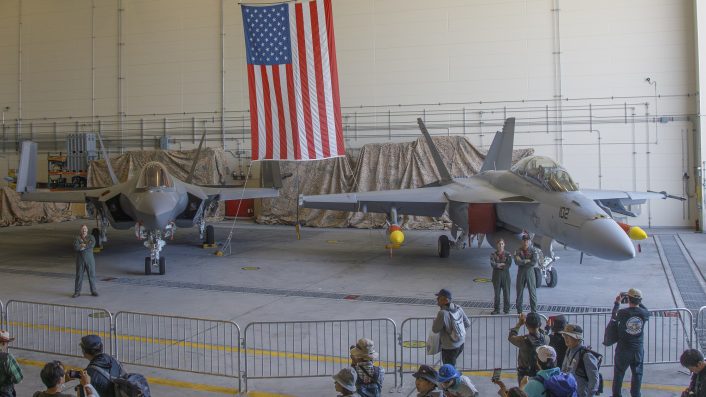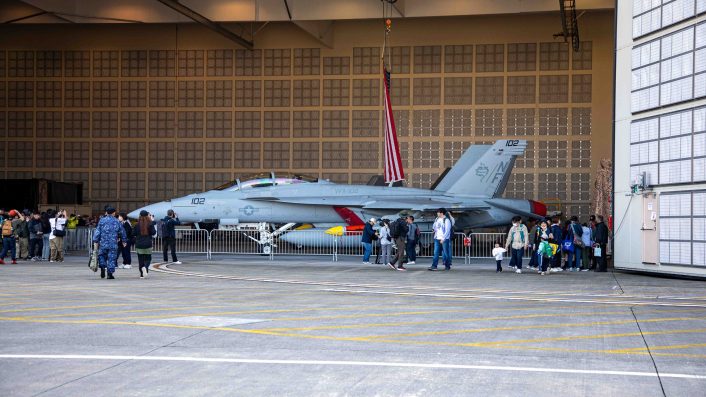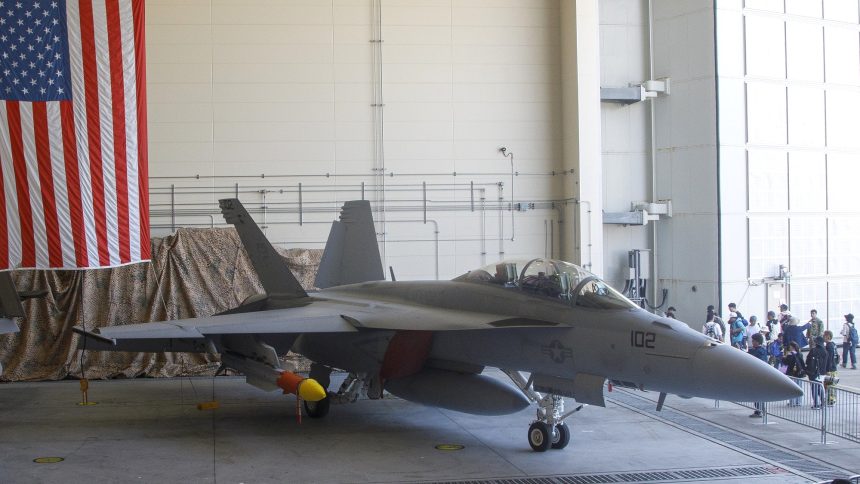The AIM-174B long-range air-to-air missile made what could possibly be its first public appearance since it was fielded during the JMSDF-MCAS Iwakuni Friendship Day.
MCAS Iwakuni, Japan, hosted on May 4, 2025, the Japan Maritime Self-Defense Force-Marine Corps Air Station Iwakuni Friendship Day, which is held annually to strengthen relationships with the host community and offer a cultural exchange that highlights the mutual support between the U.S. and Japan. On that occasion, two AIM-174B long-range air-to-air missiles (AAM) made an appearance under the wings of a U.S. Navy F/A-18F Super Hornet assigned to Strike Fighter Squadron (VFA) 102, Carrier Air Wing (CVW) 5.
MCAS Iwakuni held the JMSDF-MCAS Iwakuni Friendship Day, May 4, 2025. It was a vibrant, fun-filled day of aerial performances, ground displays, delicious food, and cultural exchange! pic.twitter.com/Mf2fXdLbXg
— U.S. Forces Japan (@USForcesJapan) May 6, 2025
The aircraft was on display together with an F-35C Lightning II of VFA-147 inside Hangar 5300. This could be the first appearance of the AIM-174B in a public event since it was fielded by the U.S. Navy in mid-2024. The Super Hornet was only carrying the two inert CATM-174B variants of the weapon on the inner pylons, in addition to an external fuel tank on the centerline.

The AIM-174 made its first appearance on U.S. Navy aircraft during RIMPAC 2024, specifically on an F/A-18E Super Hornet belonging to the VFA-192 “Golden Dragons”, CVW-2. The new photos now confirm the deployment of the weapon with CVW-5, the only permanently forward-deployed air wing, assigned to the USS George Washington (CVN 73).
The long-range AAM is considered to be intended for a possible fight in the Pacific theatre, where it would overcome some of the restrictions caused by China’s anti-access capabilities. Such a weapon would allow to reach critical assets, such as AEW&C and ISR aircraft which would work under the protection of long-range air defenses.
今回の岩国FD、ミリオタの間で一番話題のAIM-174B超長距離空対空ミサイル(”超長距離”だけでシビれる)。艦載SAMのSM-6の空中発射仕様ともいえるもので、AWACSやAMRAAMをアウトレンジするASMを搭載する中国海軍のH-6など、高価値目標用と推測。はやく誰か3Dプリンタで製品化して!#岩国FD2025 pic.twitter.com/chIw4dJFmZ
— ウイングバック (@wingback_t) May 4, 2025
AIM-174B
As we’ve detailed in recent months, the AIM-174B missile is a variant of the Standard Missile 6 (SM-6) repurposed for air-to-air engagements. Originally designed as the RIM-174 Standard Extended Range Active Missile (ERAM), the SM-6 serves as the U.S. Navy’s primary long-range anti-air and anti-missile defense solution, integrated with the Aegis Combat System on Navy vessels.
The SM-6 ERAM is a key asset in the Navy’s long-range air defense strategy. Derived from the RIM-156A SM-2ER Block IV airframe and equipped with an active radar seeker from the AIM-120 AMRAAM, the SM-6 is capable of reaching Mach 3.5 and has a range of 200 nautical miles in its ship-based form.
岩国FD2025の写真、もうちょっとだけ。AIM-174B、ランチャー介さずにパイロンに直付けなんですよね…インターフェイスどうなってんだろ?#岩国FD2025 pic.twitter.com/9i72wlwDb7
— ウイングバック (@wingback_t) May 4, 2025
While traditionally ship-launched, the SM-6 has been tested in air-launched configurations as early as 2018 and again in 2021 on other VX-31 Super Hornets, but only this year has its deployment accelerated, with further involvement from operational units.
In April 2024, an F/A-18 was spotted carrying the AIM-174, then, on Jul. 2, 2024, an F/A-18E Super Hornet belonging to the VFA-192 “Golden Dragons” was photographed taxiing at Joint Base Pearl Harbor-Hickam, Hawaii, carrying two AIM-174B missiles marking the first appearance of the missile on a frontline platform during RIMPAC 2024. At the beginning of September, images of VX-9’s Super Hornet carrying four AIM-174s mounted on both inner and middle hardpoints, along with AIM-120s set a new benchmark for its air-to-air load capacity. Additionally, the ASG-34A IRST integrated on the fuel tank complemented the Super Hornet’s radar, providing advanced tracking capability in electronic warfare or radar-denied settings.

While details on the air-launched AIM-174B’s maximum range remain unclear, it is likely to exceed the surface-launched version when launched at altitude and speed, positioning it among the longest-range air-to-air weapons in the U.S. inventory and filling the void left by the retirement of the AIM-54 Phoenix.
Officially acknowledged in July as operationally deployed with CVW-2 aboard the USS Carl Vinson, the AIM-174B’s availability in IOC (Initial Operating Capability) extends the U.S. Navy’s reach in long-range engagement. Although publicly seen with only inert and training versions, live missiles are likely already available in the fleet.
As we explained in a previous post:
With the induction of the AIM-174B into service, the U.S. Navy joins a number of air arms capable of deploying an extra-long-range beyond-visual-range air-to-air missile (BVRAAM), like the MBDA Meteor, the Russian R-37M and Chinese PL-15 and PL-21. In fact, the AIM-174B enables the U.S. Navy Super Hornets to engage targets at much greater distances than is currently possible with the AIM-120 AMRAAM. Integrated with the E-2D, F-35, and AEGIS within the Naval Integrated Fire Control-Counter Air (NIFC-CA) system, the AIM-174B would extend the Navy’s capability to intercept aerial targets at ranges comparable to (if not greater than) those achieved against naval targets using the baseline SM-6.
In essence, this new missile fills the gap left by the retirement of the AIM-54 Phoenix. The AIM-54 was a long-range air-to-air missile used by the U.S. Navy’s F-14 Tomcat and retired in 2004 alongside the F-14. Known for its impressive range of over 100 nautical miles and multiple-target engagement capability, the AIM-54 left a significant void in long-range engagement capabilities.
While there wasn’t a direct replacement for the AIM-54 Phoenix in terms of range, the U.S. military has been developing advanced air-to-air missiles to enhance its fighter aircraft capabilities. The AIM-260 Joint Advanced Tactical Missile (JATM) is one such development intended to replace the AIM-120 AMRAAM. Although not a direct replacement for the AIM-54 Phoenix, the AIM-260 aims to offer improved range and performance compared to the AIM-120.









